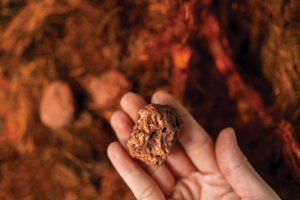Freshly listed SensOre could have the exploration upper hand with its AI tech

Pic: Vincent Besnault (DigitalVision) via Getty Images.
Listing just over a week ago, SensOre (ASX:S3N) is more than your average mining company.
It’s got a suite of gold exploration projects in the Yilgarn Craton in WA and has exposure to the battery and critical metals sector through its farm-in to the Moonera and Auralia projects.
Plus, the company has developed AI-enhanced technology which analyses geoscience data to increase the potential for mineral discovery.
CEO Richard Taylor says it’s about a more strategic approach to exploration.
“SensOre is really focused on that battery mineral thematic at the moment and reducing the carbon footprint of the industry by more surgical strategic drilling, rather than the more random conventional approach that has been historically applied,” he said.
“So good data, less drilling, more discoveries hopefully.”
Just a few days after listing, SensOre proved true to its word, announcing that first pass RC drilling at its Balagundi JV has intersected gold in the central target area.
The $48.5m market cap company plans a larger follow up drilling program in Q2.
Giant data sets help pinpoint opportunities
Essentially, the company made a big capital investment in data acquisition, including geological maps and reports, geophysics data like gravity magnetics, airborne EM, seismic and even magnetotellurics – which is a way of measuring the performance of the Earth’s surface in relation to lightning strikes.
The company also collected a massive database of geochemistry data, with surface samples and drilling assays that have been collected by the industry over the last decade.
“We pull that into something like a full body scan, in medical terms,” Taylor said.
“So, we brought up this whole picture of the Earth’s surface and the underlying geological structures, and then we train it on deposits and how to look for other deposits.
“Each deposit has its own impression in the data and … when looking in our system for where you’ll find gold, it’s often where there has been a gold mine previously, or similarly for copper nickel, and lithium.”
Bringing new life to brownfields
Taylor said the main advantage of the AI tech is discovering new deposits in areas that have been mined for a long period of time.
“We’re pretty good at finding the stuff that’s sticking out of the ground,” he said.
“We’ve been all over Australia, looking for outcrops of gold but about two thirds of the continent is under cover, under sand or sediment or under geology that thrusts over more perspective areas.
“What we do is we take our data, and we push that knowledge from the known outcrop areas under along new terrains.
“And we know that those areas are fertile for discovery because they’ve hosted lots and lots of mines previously. But most of those mines are constrained to the outcrop areas, so we’re opening up vast new areas of the continent for new exploration.”
A solid suite of projects
While the company works with bigger players like BHP (ASX:BHP) and 29Metals (ASX:29M), they also use their technology to pursue their own exploration projects.
“We’ve used the technology to identify about 15 tenement packages that are prospective for base and precious metals,” Taylor said.
“A lot of companies will provide you with advice, but they won’t go that next mile to be able to capture the ground, understand the geology, drill the holes and give investors the opportunity to participate in the output and benefits from a technology – rather than seeing it captured by some of the majors or who you would be working for as a traditional mining technology company.”
SensOre has picked up a large tenement package around Leonora, near the Gwalia St Barbara mine, and has a project called Eagle Hawk, which is just on the southern extension of the Great Border Resources (ASX:GBR) recent Mulga Bill discovery.
“We have Maynards Dam, which is out near St Ives, and we just confirmed a new JV agreement with LeFroy (ASX:LEX) at Marloo,” Taylor said.
“And we’ve also got Mount Magnet, which is up near Ramelius’ (ASX:RMS) Mount Magnet operation.
“We have a very solid and fast-growing technology business that’s generating revenue for the company, but we also have exposure to when that technology identifies something particularly special, our own exploration can provide that exponential uplift of discovery.”
UNLOCK INSIGHTS
Discover the untold stories of emerging ASX stocks.
Daily news and expert analysis, it's free to subscribe.
By proceeding, you confirm you understand that we handle personal information in accordance with our Privacy Policy.








